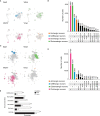Single-Cell Transcriptomic Reveals Dual and Multi-Transmitter Use in Neurons Across Metazoans
- PMID: 33597849
- PMCID: PMC7883486
- DOI: 10.3389/fnmol.2021.623148
Single-Cell Transcriptomic Reveals Dual and Multi-Transmitter Use in Neurons Across Metazoans
Abstract
Neurotransmitter expression is widely used as a criterion for classifying neurons. It was initially thought that neurons express a single type of neurotransmitter, a phenomenon commonly recognized as Dale's principle: "one neuron, one transmitter." Consequently, the expression of a single neurotransmitter should determine stable and distinguishable neuronal characteristics. However, this notion has been largely challenged and increasing evidence accumulates supporting a different scenario: "one neuron, multiple neurotransmitters." Single-cell transcriptomics provides an additional path to address coexpression of neurotransmitters, by investigating the expression of genes involved in the biosynthesis and transmission of fast-acting neuromodulators. Here, we study neuronal phenotypes based on the expression of neurotransmitters, at single-cell resolution, across different animal species representing distinct clades of the tree of life. We take advantage of several existing scRNAseq datasets and analyze them in light of neurotransmitter plasticity. Our results show that while most neurons appear to predominantly express a single type of neurotransmitter, a substantial number of neurons simultaneously expresses a combination of them, across all animal species analyzed.
Keywords: Dale's principle; metazoans; neurons; neurotransmitter; scRNAseq.
Copyright © 2021 Brunet Avalos and Sprecher.
Conflict of interest statement
The authors declare that the research was conducted in the absence of any commercial or financial relationships that could be construed as a potential conflict of interest.
Figures









References
LinkOut - more resources
Full Text Sources
Other Literature Sources

